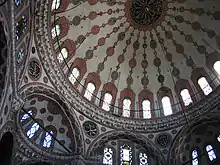گلنوش سلطان
گلنوش سلطان، (متولد ۱۶۴۷ ونیز – درگذشته ۶ نوامبر ۱۶۱۵) با نام کامل امتالله ماهپاره رابعه گلنوش سلطان، همسر محمد چهارم و تنها خاصگی سلطان او، هچنین والده سلطان مصطفی دوم و احمد سوم بود.یکی از چهره های بر جسته در دوره سلطنت زنان بود. گلنوش سلطان بعد از ماهپیکر سلطان تنها زنی بود که دو پسرش به سلطنت رسیدند و دوبار والده سلطان شد.وی آخرین زن قدرتمند و با نفوذ در امپراطوری عثمانی بود.
| رابعه گلنوش سلطان | |||||
|---|---|---|---|---|---|
 پرتره نقاشی شده از رابعه گلنوش سلطان در قرن نوزدهم | |||||
| والده سلطان | |||||
| تصدی | ۱۶۹۵–۱۷۱۵ | ||||
| پیشین | دلآشوب سلطان | ||||
| جانشین | صالحه سلطان | ||||
| خاصگی سلطان | |||||
| تصدی | ۱۶۵۹–۱۶۸۷ | ||||
| پیشین | هماشاه سلطان | ||||
| جانشین | لغو موقعیت | ||||
| زاده | اومانیاوریا ۱۶۴۷ ونیز | ||||
| درگذشته | ۶ نوامبر ۱۷۱۵ (۶۸ سال) استانبول، امپراتوری عثمانی | ||||
| آرامگاه | |||||
| همسر(ان) | محمد چهارم | ||||
| فرزند(ان) | . خدیجه سلطان
. مصطفی دوم . گلثوم سلطان . احمد سوم . فاطمه سلطان | ||||
| |||||
| دین و مذهب | اسلام، پیش تر مسیحیارتودکس | ||||
گلنوش سلطان دختر کشیش یونانی بود که در ونیز متولد شد. نام او به معنای گل زیبا است. وی به مدت ۲۰ سال والده سلطان قدرتمندی بود. مسجد ینی والده در استانبول از جمله آثاری است که به فرمان گلنوش سلطان ساخته شد.[1][2][3][4][5][6][7][8]

نگاره ای از مسجد ینی والده
پانویس
- Baker, Anthony E (1993). The Bosphorus. Redhouse Press. p. 146. ISBN 975-413-062-0.
The Valide Sultan was born Evmania Voria, daughter of a Greek priest in a village near Rethymnon on Crete. She was captured by the Turks when they took Rethymnon in 1645.
- Freely, John (1996). Istanbul: the imperial city. Viking. p. 242. ISBN 0-14-024461-1.
Rabia Gulnus a Greek girl who had been captured in the Ottoman invasion of Crete. Râbi'a Gülnûş was the mother of Mehmet’s first two sons, the future sultans Mustafa II and Ahmet III.
- Bromley, J. S. (1957). The New Cambridge Modern History. University of California: University Press. p. 554. ISBN 0-521-22128-5.
the mother of Mustafa II and Ahmed III was a Cretan.
- Library Information and Research Service (2005). The Middle East. Library Information and Research Service. p. 91.
She was the daughter of a Cretan (Greek) family and she was the mother of Mustafa II (1664–1703), and Ahmed III (1673–1736).
- Thys-Şenocak, Lucienne (2006). Ottoman women builders. Ashgate. p. 46. ISBN 0-7546-3310-1.
The sultan appears to have been in no hurry to leave his prized concubine from the Ottoman conquest of Rethymnon, Crete – the haseki Emetullah Gulnus, and their new son Mustafa.
- Buturović, Amila; Schick, İrvin Cemil (2007). Women in the Ottoman Balkans: gender, culture and history. I.B.Tauris. p. 24. ISBN 1-84511-505-8.
Mahpeikir [Kösem Mahpeyker] and Revia Gülnûş [Rabia Gülnûş] were Greek.
- Freely, John (2000). Inside the Seraglio: private lives of the sultans in Istanbul. Penguin. p. 163.
Mehmet had by now set up his own harem, which he took with him in his peregrinations between Topkapi Sarayi and Edirne Sarayi. His favourite was Rabia Gülnûş Ummetüllah, a Greek girl from Rethymnon.
- Freely, John (2001). The lost Messiah. Viking. p. 132. ISBN 0-670-88675-0.
He set up his harem there, his favourite being Rabia Giilniis Ummetiillah, a Greek girl from Rethymnon on Crete.
منابع
- مشارکتکنندگان ویکیپدیا. «Emetullah Rabia Gülnuş Sultan». در دانشنامهٔ ویکیپدیای انگلیسی، بازبینیشده در ۲۰ نوامبر ۲۰۱۴.
- «Emetullah_Rabia_Gülnuş_Sultan». بایگانیشده از اصلی در ۲۴ سپتامبر ۲۰۱۵. دریافتشده در ۲۰ نوامبر ۲۰۱۴.
- «وقفهاى زنان عثمانى و وقفيه والده سلطان ماه پيكر» (PDF).
This article is issued from Wikipedia. The text is licensed under Creative Commons - Attribution - Sharealike. Additional terms may apply for the media files.
.svg.png.webp)